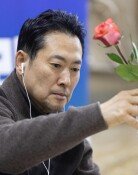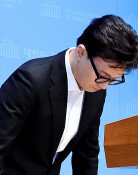Separated families longing for reunions with loved ones
Separated families longing for reunions with loved ones
Posted August. 24, 2013 06:20,
South Korean poet Jeong Seong-soo has been separated from family in North Korean since the Korean War. The hometown of his mother, Goh Bu-jeon, is an area (Kaesong) in the North that is famous for Seonjuk-gyo bridge and Bakyeon Falls. Until her mother passed away at the age of 77 in 1991, she had no chance to revisit her hometown that she had so badly missed. The days of her pain and suffering have regained life as they were incorporated in poems of her son. Eight of his poems on ardently sad episodes of separated families, including If it rains again, separate families shed tears, received the grand prize at this years Kim Woo-jong Literary Award. When the poet was young, his mother would tell the poet stories from her hometown whenever she had a chance, and cook him delicious bossam (steamed pork with vegetables) kimchi and cheonggukjang (soup with fast-fermented soy paste) that can be tasted nowhere else. When fleeing from the North during the war, she lost her one-year-old daughter right before her eyes. The poet gets deeply anxious even today about whether "the mother might be wandering around amid dark skies over the North even after her death because she lost her path towards her hometown."
Painter Seo Yong-seon, who was born in 1951 during the war, hosted the exhibition Seo Yong-seon and the Korean War: Memories and recollection, which collectively exhibited masterpieces embodying memories of war, at Korea University Museum in June. It was a showcase of his efforts to translate the past into history, which he was able to complete through his sense of sincere responsibility, while deeply regretting the reality that innocent sacrifices caused by war get forgotten too easily. Among his artworks, The Pinan (Fleeing from War) was created with a documentary photo of a parade of people fleeing the North across the iron rail bridge on January 4 (1951) Retreat over the Daedong River that had been damaged by bombing. Because of blurry images of their facial looks in the picture, it is difficult to identify people who are carrying children in their back and others moving tons of freight amid bone-chilling weather, as they climb up the bridge comprised only of skeletons. It seems like the artist invites viewers to juxtapose countless anonymous victims, who were suppressed under the wheel of history, onto the scene.
About 56,000, or more than 40 percent of the 128,800 people in the South who had applied for reunion of their separated families in the North, already passed away. About 80 percent of the surviving people are elderly people aged 70 or older. With no powerful labor unions who will speak for them, these people do not know how to use now ubiquitous, impactful social media networks silently shout, just waiting perpetually. They shout that a unification that would free people from the pain of separation is more important than a unification that is attained by verbal chanting of slogans. If a 90-year-old mother can feed side dishes to her 70-year-old son as in the past, and the 70-year-old son can lightly carry in the back his 90-year-old mother again, (excerpt from Jeong Seong-soos That is reunification, if we meet often)
It rained on Friday, when the Red Cross organizations from the South and North Korea held working-level talks to arrange reunion of separated families. Perhaps the rain was the burden of sadness weighing on the separated families, who are living perilous life as if they are turning the last page every day amid heartbreaking emotion of yearning.
Editorial Writer Koh Mi-seok (mskoh119@donga.com)






![[김순덕의 도발] ‘李부터 연임’ 개헌, 이 대통령은 가능성을 말했다](https://dimg.donga.com/c/138/175/90/1/wps/NEWS/IMAGE/2026/01/16/133172656.1.jpg)
